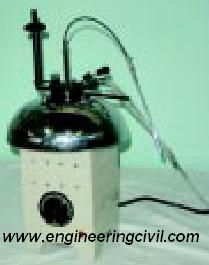This test is done to determine the flash point and the fire point of asphaltic bitumen and fluxed native asphalt, cutback bitumen and blown type bitumen as per IS: 1209 – 1978. The principle behind this test is given below :
Flash Point – The flash point of a material is the lowest temperature at which the application of test flame causes the vapours from the material to momentarily catch fire in the form of a flash under specified conditions of the test.
Fire Point – The fire point is the lowest temperature at which the application of test flame causes the material to ignite and burn at least for 5 seconds under specified conditions of the test.
The apparatus required for this test is
i) Pensky-Martens apparatus
ii) Thermometer- Low Range : -7 to 110oC, Graduation 0.5oC
High Range : 90 to 370oC, Graduation 2oC
The sample should be just sufficient to fill the cup upto the mark given on it.

Procedure to determine the Flash And Fire Point Of Bitumen
A) FLASH POINT
i) Soften the bitumen between 75 and 100oC. Stir it thoroughly to remove air bubbles and water.
ii) Fill the cup with the material to be tested upto the filling mark. Place it on the bath. Fix the open clip. Insert the thermometer of high or low range as per requirement and also the stirrer, to stir it.
iii) Light the test flame, adjust it. Supply heat at such a rate that the temperature increase, recorded by the thermometer is neither less than 5oC nor more than 6oC per minute.
iv) Open flash point is taken as that temperature when a flash first appears at any point on the surface of the material in the cup. Take care that the bluish halo that sometimes surrounds the test flame is not confused with the true flash. Discontinue the stirring during the application of the test
flame.
v) Flash point should be taken as the temperature read on the thermometer at the time the flash occurs.
B) FIRE POINT
i) After flash point, heating should be continued at such a rate that the increase in temperature recorded by the thermometer is neither less than 5oC nor more than 6oC per minute.
ii) The test flame should be lighted and adjusted so that it is of the size of a bead 4mm in dia.
REPORTING OF RESULTS
i) The flash point should be taken as the temperature read on the thermometer at the time of the flame application that causes a distinct flash in the interior of the cup.
ii) The fire point should be taken as the temperature read on the thermometer at which the application of test flame causes the material to ignite and burn for at least 5 seconds.
If you have a query, you can ask a question here.



thanks sir! For clearing my doubt.
What is the flash point values of all types of bitumen As ASTM D92 ,D93
Around 175 °C